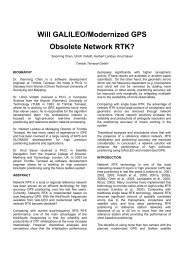GPS Integrity and Potential Impact on Aviation Safety - intelligent ...
GPS Integrity and Potential Impact on Aviation Safety - intelligent ...
GPS Integrity and Potential Impact on Aviation Safety - intelligent ...
Create successful ePaper yourself
Turn your PDF publications into a flip-book with our unique Google optimized e-Paper software.
NO. 1 <str<strong>on</strong>g>GPS</str<strong>on</strong>g> AND AVIATION SAFETY 59<br />
approaches to the m<strong>on</strong>itoring of integrity of satellite-based navigati<strong>on</strong> systems are<br />
external m<strong>on</strong>itoring <str<strong>on</strong>g>and</str<strong>on</strong>g> Receiver Aut<strong>on</strong>omous <str<strong>on</strong>g>Integrity</str<strong>on</strong>g> M<strong>on</strong>itoring (RAIM). Complex<br />
systems such as GNSS also employ integral/built-in mechanisms for self-checks to<br />
offer a degree of integrity assurance. An example of this is a c<strong>on</strong>cept known as Satellite<br />
Aut<strong>on</strong>omous <str<strong>on</strong>g>Integrity</str<strong>on</strong>g> M<strong>on</strong>itoring (SAIM), which is based <strong>on</strong> the m<strong>on</strong>itoring of the<br />
performance of the frequency generati<strong>on</strong> mechanism <strong>on</strong> board the satellite. Various<br />
checks are also built in, for example, at functi<strong>on</strong>al <str<strong>on</strong>g>and</str<strong>on</strong>g> algorithmic levels within the<br />
c<strong>on</strong>trol <str<strong>on</strong>g>and</str<strong>on</strong>g> space segments.<br />
External m<strong>on</strong>itoring relies <strong>on</strong> a number of ground stati<strong>on</strong>s, positi<strong>on</strong>ed at known<br />
locati<strong>on</strong>s (Fernow <str<strong>on</strong>g>and</str<strong>on</strong>g> Loh, 1994). Individual satellites are then m<strong>on</strong>itored by comparing<br />
the measured pseudo-ranges with those computed from the coordinates of the<br />
satellite <str<strong>on</strong>g>and</str<strong>on</strong>g> m<strong>on</strong>itor stati<strong>on</strong>. If a measurement error exceeds a certain threshold,<br />
indicating that a satellite is faulty, then a warning is sent to the users within the timeto-alert.<br />
This is a powerful approach to integrity m<strong>on</strong>itoring, since it directly isolates<br />
the faulty satellite, enabling navigati<strong>on</strong> to c<strong>on</strong>tinue if sufficient satellites are still available.<br />
It is ideal for m<strong>on</strong>itoring system errors (c<strong>on</strong>trol <str<strong>on</strong>g>and</str<strong>on</strong>g> space segments). However,<br />
the approach is not able to identify problems local to the user (e.g. multipath). This<br />
problem is addressed by a method that relies <strong>on</strong> actual measurements used in the<br />
positi<strong>on</strong>ing soluti<strong>on</strong>.<br />
The RAIM method is applied within the user receiver to enable it to independently<br />
or aut<strong>on</strong>omously establish system integrity. RAIM attempts to address two main<br />
c<strong>on</strong>cerns, the existence of a bad measurement <str<strong>on</strong>g>and</str<strong>on</strong>g> the identificati<strong>on</strong> of the affected<br />
satellite. If a GNSS is used for supplemental navigati<strong>on</strong>, then addressing the first<br />
c<strong>on</strong>cern is sufficient because an alternative navigati<strong>on</strong> system is available <str<strong>on</strong>g>and</str<strong>on</strong>g> can be<br />
used instead. However, if the GNSS is used for primary-means navigati<strong>on</strong>, then both<br />
c<strong>on</strong>cerns above must be fully addressed to identify <str<strong>on</strong>g>and</str<strong>on</strong>g> remove the affected measurement<br />
(satellite) from the soluti<strong>on</strong> allowing the aircraft to proceed safely. Addressing<br />
either c<strong>on</strong>cern requires redundant measurements, i.e. more than the minimum four<br />
measurements required for a positi<strong>on</strong> soluti<strong>on</strong>. Hence, measurements from at least five<br />
satellites are required to detect a satellite anomaly, <str<strong>on</strong>g>and</str<strong>on</strong>g> a minimum of six satellites to<br />
remove the affected satellite from the navigati<strong>on</strong> soluti<strong>on</strong>. A RAIM technique must<br />
determine a positi<strong>on</strong> error <str<strong>on</strong>g>and</str<strong>on</strong>g> make a decisi<strong>on</strong> as to whether the level of error is acceptable<br />
by comparing it to the alert limit for a particular phase of flight. If this limit is<br />
exceeded, then a RAIM equipped receiver must issue a warning within the time-to-alert.<br />
A number of algorithms for RAIM have been developed including positi<strong>on</strong> comparis<strong>on</strong>,<br />
range comparis<strong>on</strong>, residual analysis <str<strong>on</strong>g>and</str<strong>on</strong>g> parity checking (Brown, 1996). It can<br />
be shown that these methods are basically the same, provided that care is taken in the<br />
selecti<strong>on</strong> of the required thresholds. Preference for <strong>on</strong>e over the other is usually for<br />
reducing computati<strong>on</strong>al complexity. RAIM has the advantages that it protects against<br />
interference with the SIS, exists regardless of an external m<strong>on</strong>itoring capability, <str<strong>on</strong>g>and</str<strong>on</strong>g><br />
protects against anomalies associated with signal propagati<strong>on</strong>. However, the reliance<br />
<strong>on</strong> redundant measurements to detect <str<strong>on</strong>g>and</str<strong>on</strong>g> isolate bad measurements is a major<br />
drawback because it lowers availability. It is not always possible to carry out a RAIM<br />
computati<strong>on</strong> if, for instance, the user receiver is at a poor locati<strong>on</strong> in the coverage area<br />
of the GNSS c<strong>on</strong>stellati<strong>on</strong>, or if satellites are masked or lost during aircraft manoeuvres.<br />
The power of RAIM could be increased by adding measurements from other<br />
instruments <strong>on</strong> board the aircraft. The technique is then no l<strong>on</strong>ger receiver aut<strong>on</strong>omous<br />
but aircraft aut<strong>on</strong>omous, AAIM. AAIM can be applied by adopting the loosely



